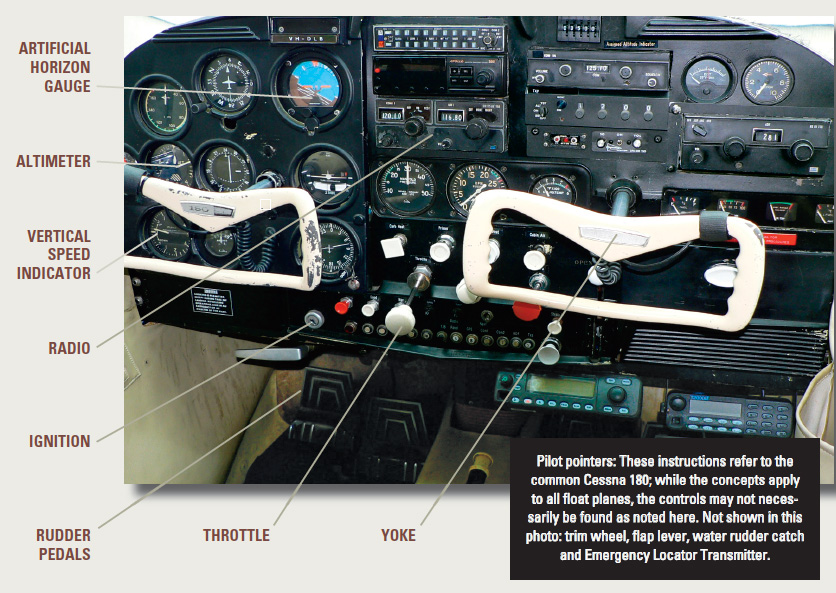Follow these 8 steps to get yourself back on the water in an emergency
Advertisement
Okay, you’re flying off on that long-awaited fishing trip with your buddies when your float plane’s pilot slumps over in his seat, unconscious. You’re in the co-pilot’s seat, so you try to wake him. It’s no use. What to do? There’s only one thing you can do: try to get the plane back down on the water.
Most of us have darkly fantasized about landing a float plane in an emergency. Well, here’s your chance, so keep cool, follow these steps and just maybe you’ll wind up a hero.
Advertisement
Or not. But it’s sure worth a shot.
- Get your hands on the yoke, your feet on the rudder pedals and take control of the plane. And be gentle. Aircraft in stable flight will carry on just fine for many minutes without your input. In the meantime, familiarize yourself with the feel of the controls. The rudder pedals push the nose of the plane to the right or left. The yoke lowers and raises the nose as you push forward and pull back. And you can raise and lower the wing tips by turning the yoke.
- Observe the landscape below you. Are you flying level, or are you climbing or descending? Also, look ahead through the windshield and you’ll notice that when you’re in level flight, the top of the engine cowling is more or less fixed on the distant horizon. Consult the instrument panel, too. The artificial horizon gauge has an airplane symbol imposed over a horizon line—they should be aligned. The altimeter, meanwhile, has a needle that shows if you’re climbing or descending.
- Once you know you’re flying level, it’s a good time to pick up the radio and call for help. Push the microphone button and announce “mayday” several times. In most float plane regions, there’s a mandatory frequency for pilots to broadcast their positions, so the radio should already be dialled into it. If you announce “I’m not a pilot, someone help me land this thing,” you might connect with a pilot who will help. If you can’t get the radio to work, get one of your buddies to look for and activate the Emergency Locator Transmitter (in some planes, it’s the orange box strapped to the ceiling of the cockpit). Heck, activate it regardless. As soon as you do, the cavalry is on its way.
- Now search for a nice, long stretch of water, one that preferably enables you to land into the wind. If you’re in Canadian Shield country, there will be no shortage of good landing zones. In built-up country, a straight highway will do, and no one will begrudge you the scraped-up pontoons.
- Once you’ve picked out your landing zone, aim the top of the engine cowling at the spot where you want to land. Keeping the airplane straight and level, gently reduce the throttle (a knob emerging from the dashboard) by pulling it back. As the plane slows down, engage the flaps (the flap lever is between the seats, and it looks like a parking brake; pull it up to the first setting). If you feel the controls fighting back, you can balance them by adjusting the trim wheel (beneath the throttle or between the seats). Fiddle with the throttle setting until you’re descending at about 500 feet per minute. Both the altimeter and the vertical speed indicator will show your rate of descent. In most float planes, 70 knots is a good speed for descent and approach. Now pull up another notch of flap, and trim the plane once again. If your speed begins to increase past 70 knots, reduce the throttle.
- You can prevent overshooting or undershooting the landing zone by watching how the engine cowling moves in relation to your selected landing area. If the landing area is moving under the nose, you’re going to overshoot. Try decreasing power. If the reference point is moving upward from the nose, you’re going to undershoot, so add a little more power.
- When the plane is about 20 feet above the landing area, cut the power to zero and gently lift the nose above the horizon. Now the plane will begin to settle. The controls get mushy at low speed, so be prepared to use more exaggerated adjustments to keep it straight. To prevent the floats from catching, raise the nose by pulling all the way back on the yoke until the plane touches down.
- For better control while taxiing on water, activate the water rudders on the floats (the catch is on the floor between the seats) and steer the plane toward the nearest, easily accessed shoreline. Just as you get to shore, kill the engine by turning off the ignition. When the propeller finally stops turning, climb out and take a well-deserved jump onto sweet, solid land.

